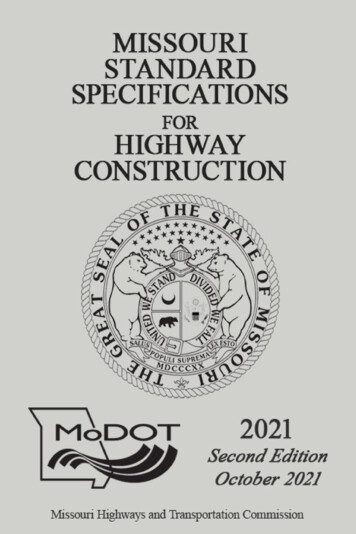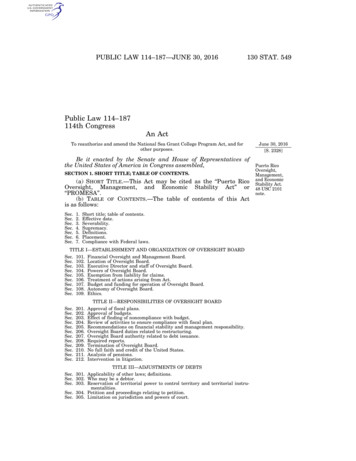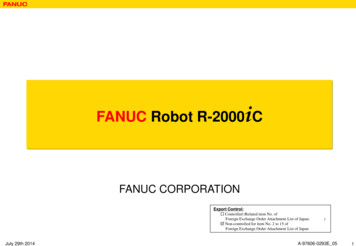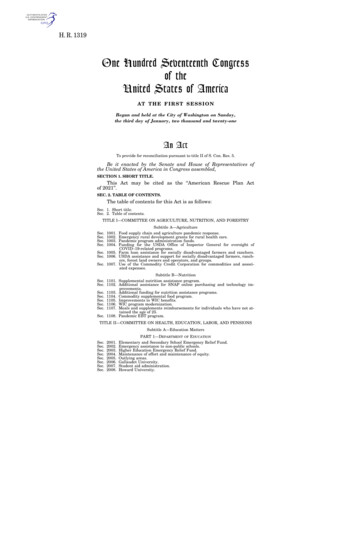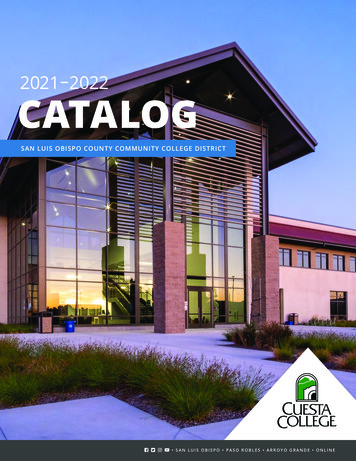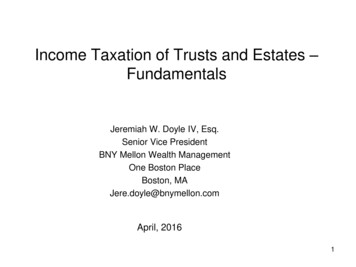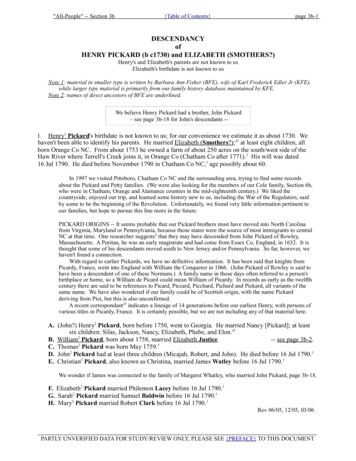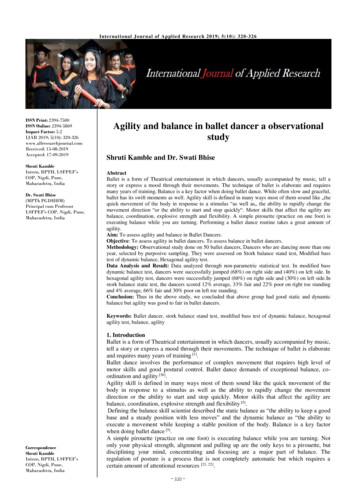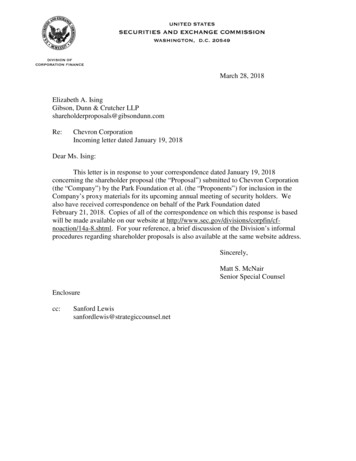
Transcription
March 28, 2018Elizabeth A. IsingGibson, Dunn & Crutcher LLPshareholderproposals@gibsondunn.comRe:Chevron CorporationIncoming letter dated January 19, 2018Dear Ms. Ising:This letter is in response to your correspondence dated January 19, 2018concerning the shareholder proposal (the “Proposal”) submitted to Chevron Corporation(the “Company”) by the Park Foundation et al. (the “Proponents”) for inclusion in theCompany’s proxy materials for its upcoming annual meeting of security holders. Wealso have received correspondence on behalf of the Park Foundation datedFebruary 21, 2018. Copies of all of the correspondence on which this response is basedwill be made available on our website at a-8.shtml. For your reference, a brief discussion of the Division’s informalprocedures regarding shareholder proposals is also available at the same website address.Sincerely,Matt S. McNairSenior Special CounselEnclosurecc:Sanford Lewissanfordlewis@strategiccounsel.net
March 28, 2018Response of the Office of Chief CounselDivision of Corporation FinanceRe:Chevron CorporationIncoming letter dated January 19, 2018The Proposal requests a report on the Company’s actions beyond regulatoryrequirements to minimize methane emissions, particularly leakage, from the Company’shydraulic fracturing operations.We are unable to concur in your view that the Company may exclude the Proposalunder rule 14a-8(i)(7). Accordingly, we do not believe that the Company may omit theProposal from its proxy materials in reliance on rule 14a-8(i)(7).Sincerely,Caleb FrenchAttorney-Adviser
DIVISION OF CORPORATION FINANCEINFORMAL PROCEDURES REGARDING SHAREHOLDER PROPOSALSThe Division of Corporation Finance believes that its responsibility with respectto matters arising under Rule 14a-8 [17 CFR 240.14a-8], as with other matters under theproxy rules, is to aid those who must comply with the rule by offering informal adviceand suggestions and to determine, initially, whether or not it may be appropriate in aparticular matter to recommend enforcement action to the Commission. In connectionwith a shareholder proposal under Rule 14a-8, the Division’s staff considers theinformation furnished to it by the company in support of its intention to exclude theproposal from the company’s proxy materials, as well as any information furnished bythe proponent or the proponent’s representative.Although Rule 14a-8(k) does not require any communications from shareholdersto the Commission’s staff, the staff will always consider information concerning allegedviolations of the statutes and rules administered by the Commission, including argumentsas to whether or not activities proposed to be taken would violate the statute or ruleinvolved. The receipt by the staff of such information, however, should not be construedas changing the staff’s informal procedures and proxy review into a formal or adversarialprocedure.It is important to note that the staff’s no-action responses to Rule 14a-8(j)submissions reflect only informal views. The determinations reached in these no-actionletters do not and cannot adjudicate the merits of a company’s position with respect to theproposal. Only a court such as a U.S. District Court can decide whether a company isobligated to include shareholder proposals in its proxy materials. Accordingly, adiscretionary determination not to recommend or take Commission enforcement actiondoes not preclude a proponent, or any shareholder of a company, from pursuing anyrights he or she may have against the company in court, should the company’smanagement omit the proposal from the company’s proxy materials.
SANFORD J. LEWIS, ATTORNEYFebruary 21, 2018Via electronic mailOffice of Chief CounselDivision of Corporation FinanceU.S. Securities and Exchange Commission100 F Street, N.E.Washington, D.C. 20549Re: Shareholder Proposal to Chevron Inc. Regarding MethaneLeakage and Emissions from Hydraulic Fracturing on Behalf of ThePark FoundationLadies and Gentlemen:The Park Foundation (the “Proponent”) is beneficial owner of common stock of Chevron Inc.(the “Company”) and has submitted a shareholder proposal (the “Proposal”) to the Company. Ihave been asked by the Proponent to respond to the letter dated January 19, 2018 ("CompanyLetter") sent to the Securities and Exchange Commission by Elizabeth A. Ising of Gibson Dunn& Crutcher LLP. In that letter, the Company contends that the Proposal may be excluded fromthe Company’s 2017 proxy statement by virtue of Rule 14a-8(i)(7).I have reviewed the Proposal, as well as the letter sent by the Company, and based upon theforegoing, as well as the relevant rules, it is my opinion that the Proposal must be included in theCompany’s 2018 proxy materials and that it is not excludable by virtue of those rules. A copy ofthis letter is being emailed concurrently to Elizabeth A. Ising.SUMMARYThe Proposal requests that the Company report, using quantitative indicators, on the company'sactions beyond regulatory requirements to minimize methane emissions, particularly leakage,from the Company's hydraulic fracturing operations. Proponents request in the supportingstatement that the report include how frequently leak detection methods are employed, repairtimes for identified leaks, status of reducing high bleed pneumatic devices, methane emissionrates from drilling, completion, and production operations, and methane emissions reductiontargets.The Company Letter asserts that because the Company is a defendant in tort litigation relating toits historic role in climate change, the current Proposal on control of its current and futuremethane emissions can be excluded. Staff precedents and the facts of the matter at hand supportnon-exclusion. Companies have long sought immunity from any proposals that broadly touch onthe subject matter of pending litigation, an approach that has been rejected by the Staff.PO Box 231 Amherst, MA 01004-0231 sanfordlewis@strategiccounsel.net (413) 549-7333
Office of Chief CounselFebruary 21, 2018Page 2The Proposal here does not attempt to micromanage the company’s litigation strategy nor seekundisclosed information that is at the crux of the litigation (fault for climate change that hascaused Plaintiffs’ harm). Instead, the Proposal addresses the potential for proactive companyresponses on a recognized, significant policy issue of ongoing concern to investors – how thecompany is controlling methane emissions from its hydraulic fracturing operations.The historic role of the Company’s products and activities in contributing to climate change iswell known and acknowledged by the Company, and is the crux of the litigation, but not thesubject matter of the Proposal. The Proposal does not seek information related to the Company’spast sales of fossil fuel products nor the retrospective issues of fault that are at the heart of thelitigation. Therefore, the Proposal is not excludable under Rule 14a-8(i)(7).THE PROPOSALWHEREAS: Methane emissions contribute significantly to climate change, with an impact ofroughly 86 times that of carbon dioxide over a 20 year period. Emissions of this potent gas fromthe oil and gas sector — via venting, flaring, and leaking — has the potential to erase thepotential climate benefits of burning oil or gas instead of coal.The oil and gas industry is the largest U.S. source of methane emissions.1 The 2017 InternationalEnergy Agency's World Energy Outlook finds that methane emissions from the oil and gas valuechain are among the cheapest to abate of all anthropogenic emissions.Cost effective technological solutions exist and can be deployed immediately to substantiallyreduce methane emissions in the oil and gas industry. A small number of "super-emitter" leaksmay produce a disproportionately large portion of emissions. With advances in infrared, drone,and leak detection technology, as well as more efficient equipment, it is well within the ability ofcompanies to find and dramatically reduce their methane leaks.Peers including Exxon, Shell, and BP recently committed to a set of guiding principles to reducemethane emissions and improve transparency.2 The American Petroleum Institute announced theformation of an "Environmental Partnership" to voluntarily reduce methane emissions from U.S.oil and gas operations.3 A number of oil and gas companies have previously announced adoptionof methane reduction targets as part of the ONE Future Coalition. Chevron is the only major U.S.energy company not to join one of these initiatives.A 2016 study ranked Chevron as 17th out of the 100 highest methane emitters from latory-push-api-launch Pollution-reportpdf
Office of Chief CounselFebruary 21, 2018Page 3Although Chevron provides broad and generalized statements about its methane reductionactivities, it fails to disclose the information necessary to allow investors to assess its leakdetection and repair practices based on objective, quantitative information. In a 2017 specialmethane edition of "Disclosing the Facts" Chevron scored only two out of thirteen points on itsmethane leak detection and emission reduction management-related disclosures for its U.S.operations. Chevron's reporting substantially lags that of its peers.Given the intense and growing public scrutiny of methane emissions, Chevron must demonstrateto investors that it is taking action to reduce its methane risk. Disclosure of specific managementpractices and their impacts, especially with respect to leak detection, is the primary means bywhich investors can assess how our company is managing this important risk.RESOLVED: Shareholders request that Chevron provide a report (at reasonable cost, omittingproprietary information) using quantitative indicators, on the company's actions beyondregulatory requirements to minimize methane emissions, particularly leakage, from thecompany's hydraulic fracturing operations.SUPPORTING STATEMENT: Proponents request the report include: identifying how frequently leak detection methodologies beyond visual inspectionsare used at each U.S. facility, including equipment inspectedrepair times for identified leaksstatus of reducing high bleed pneumatic devicesmethane emission rates from drilling, completion, and production operationsmethane emissions reduction targetsANALYSISThe Proposal is not excludable under Rule 14a-8(i)(7).The Company Letter asserts that the Proposal is excludable because the Company is one ofseveral fossil fuel companies being sued for their historic role in causing climate change: . the Company is one of many defendants in eight lawsuits recently filed in multiplejurisdictions across the United States by several cities and counties (the “Plaintiffs”) whoseek relief for alleged climate change injuries In sum, the Plaintiffs allege that theCompany is liable under state tort law related to its production, promotion, and sale offossil fuels, and further allege that the Company should have historically altered itsbusiness model to transition away from fossil fuels, and that they have suffered damagesdue to the Company’s failure to do so.A proposal that attempts to dictate a firm’s litigation strategy is considered by the Staff to entailmicromanagement by shareholders on a subject matter that is outside of their expertise.Proposals that ask a company to settle or file litigation, or quantify liability in ongoing litigation,
Office of Chief CounselFebruary 21, 2018Page 4have also been found to be excludable in Staff decisions.4 In these instances, the excludedproposals dealt with management of issues of a complex nature (pending litigation) about whichstockholders, as a group, are not qualified to make informed business decisions. In effect, theseare decisions reserved to deliberation between board and management and their counsel. So, forinstance, a proposal that attempted to direct Exxon Mobil’s settlement in the Valdez oil spill wasexcludable. Exxon Mobil Corp. (avail. Mar. 21, 2000) (concurring with the exclusion of aproposal requesting immediate payment of settlements associated with oil spill as relating tolitigation strategy and related decisions).The current Proposal does not fit into this group of precedents, as it does not attempt tomicromanage the Company’s litigation strategy. It does not ask for information on the litigation,make recommendations as to how the litigation should be defended, or ask for information on thelitigation’s resolution or repercussions.As referenced in the Company Letter, the Staff has sometimes been asked by companies to allowexclusion of proposals that are not addressed to litigation strategy, but where the fulfillment ofthe proposal's request might involve a statement or admission by the company that could proveuseful to plaintiffs in current litigation. This category of potential exclusions could easilyencompass all shareholder proposals that address significant societal issues. Inevitably, in mostinstances in which companies are faced with significant social policy issues, thecontroversies also are raised in the courts. If the Staff were to allow exclusion of resolutionsbecause they might lead to some kind of statement that might be useful in ongoing litigation, thiswould have the effect of giving companies a pass on proposals on the most critical issues facingtheir businesses. As importantly, it would deprive investors of access to the shareholder proposalprocess for attention to the most significant issues facing their companies.Accordingly, the Staff rulings on shareholder resolutions that might involve some form of“admission” have been narrowly circumscribed to apply only where the resolutions cross the lineinto requiring the company to do something that is pointedly inconsistent with defense oflitigation, including reporting undisclosed information that is at the heart or crux of the litigation,such as admitting to liability or fault. In contrast, where acting on a proposal on significantpolicy issues of legitimate concern to investors, even if the proposal may potentially make somenon-core admission or information available for plaintiffs, the Staff routinely rejects exclusion.The instances in which exclusions have been allowed involved proposals requiring a company to4Chevron Corp. (Mar. 19, 2013) requesting company review of “legal initiatives against investors”; CMS EnergyCorp. (Feb. 23, 2004) requiring the company to void any agreements with two former members of managementand initiate action to recover all amounts paid to them; NetCurrents, Inc. (May 8, 2001) requesting the company tofile suit against certain of its officers for financial improprieties); Benihana National Corp. (avail. Sept. 13, 1991)report prepared by a board committee analyzing claims asserted in a pending lawsuit). In contrast, proposals thatask for an accounting of expenditures on a company issue, including attorneys’ fees related to litigation, are notexcludable, because they represent a reasonable form of shareholder oversight. For example, in General Electric(Feb. 2, 2004), the staff rejected an ordinary business argument against a proposal calling on management to reportits annual expenditures on various expenses related to the remediation, and other health and environmental impacts,of sites contaminated by PCBs. In that case, litigation related to the cleanup operations was ongoing, and theproposal explicitly requested information on GE’s spending “on attorney’s fees [and] expert fees.
Office of Chief CounselFebruary 21, 2018Page 5make an admission or concession of a core contested fact in litigation - for example, takingresponsibility for a harm that the company has not already agreed exists.An instance where the company met its burden of proving that the proposal addressed the crux ofthe litigation was in Wal-Mart Stores. Inc. (April 14, 2015). The proposal urged the board to seta goal of eliminating gender-based pay inequity at the company in the United States and reportannually to shareholders on actions taken and progress made toward that goal. The reportrequested the company include data for each grade/range regarding the proportion of male andfemale employees, the average annual hours worked by male and female employees, and theaverage hourly wage rate or annual compensation paid to male and female employees in the U.S.in the most recently completed fiscal year. The company in that instance had provided evidencethat the disclosure sought by the proposal would constitute an admission in the regional lawsuitsfiled in a series of “regional” class actions. The individual plaintiffs in those putative classactions continue to allege Company-wide gender-based pay disparities, which the companydenied existed.Similarly, in Johnson & Johnson (Feb. 14, 2012), the Proposal would have required the companyto address the “health and social welfare concerns of people harmed by adverse effects fromLevaquin,” one of the Company’s pharmaceutical products. The company was in litigation aboutprecisely whether its products caused adverse effects. As the Company noted, the report requestedin the proposal would have required a report on the very matter being litigated—“adverse effectsfrom” the company’s product.In General Electric Co. (Feb. 3, 2016) the proposal requested a report quantifying the company’sliabilities associated with discharge of chemicals into the Hudson River, while the company was adefendant in multiple pending lawsuits where those liabilities were at issue. Quantifying liabilitiesspoke directly to the outcome of the litigation.In Reynolds American Inc. (Feb. 10, 2006) Reynolds Tobacco and other tobacco manufacturerswere currently defendants in a suit alleging the use of menthol cigarettes by the AfricanAmerican community poses unique health risks to this community. The suit includes the specificallegation that the defendant tobacco manufacturers “predominately market mentholatedcigarettes to African Americans despite, conclusions that menthol may promote deeperinhalation and cause, aggravate or contribute to higher addiction rates in AfricanAmericans.” The proposal asked the company to voluntarily undertake a campaign aimed atAfrican Americans apprising them of the unique health hazards to them associated with smokingmenthol cigarettes including data showing the industry descriptors such as “light” and“ultralight” do not mean those who smoke such brands will be any less likely to incur diseasesthan those who smoke regular brands. he specificity of the proposal, going to the narrow liabilityissue of whether there were “unique health hazards” associated with African-Americans smokingmenthol cigarettes, which was being contested by the company in the litigation, made theserequested affirmations effectively go to the core of the litigation.
Office of Chief CounselFebruary 21, 2018Page 6In contrast, in decisions where the Staff declined to allow exclusion some combination ofthe following factors were involved: despite the subject matter of the proposal touching on ongoing litigation, the proposalsappropriately focused on a significant social policy issue of substantial and appropriateinvestor interest the societal impacts (emissions, health effects etc.) caused by the company's actions werewell known the crux of the litigation was retrospectively focused while the proposal was prospectivein its assessments and actions, and the subject matter of the proposal did not address issuesof fault.For instance, in The Dow Chemical Company (February 11, 2004) the ongoing litigation was acivil suit for remediation relating to the Bhopal disaster pending in the Southern District of NewYork; there was also a criminal action against Dow/Union Carbide pending in India. Theproposal requested that the management of Dow Chemical prepare a report to shareholdersdescribing new initiatives instituted by the management to address the specific health,environmental and social concerns of the survivors of the Bhopal tragedy. Even though thecompany argued that “the Proposal asks the Company to effect an action that is precisely whatthe Company’s subsidiary is arguing in the pending litigation that it has no obligation to do.,” asin the present case, the Staff found that the issues that the proposal would have touched upon didnot go to the issues of fault that were the crux of the litigation.In contrast to the menthol cigarettes proposal described above, in R.J. Reynolds TobaccoHoldings, Inc. ( March 7, 2002), the Staff found a proposal not excludable despite its extensiverecommendations for disclosure on cigarette packages making information known regarding‘cigarette price, brand availability and average tar and nicotine yields’ and asking that everypackage of our tobacco products include full and truthful information regarding ingredients thatmay be harmful to the consumer’s health, the toxicity of the specific brand, and what detrimentto life-expectancy the consumer may expect to incur from regular use of the product, as well asthe health hazards for others, especially children, connected with environmental tobacco smoke.In this instance, even though there was ongoing litigation about harm associated with cigarettes,all of the information sought by the proposal was readily available in public records andscientific literature and did not require any admission by the company.In RJ Reynolds (March 7, 2000) the resolution called for RJR Nabisco to create an independentcommittee to investigate retail placement of tobacco products, in an effort to prevent theft byminors. The company argued that due to two current lawsuits (against FDA and theCommonwealth of Massachusetts on regulations on retail placement) the Proposal, ifimplemented, would interfere with litigation strategy by asking the company to take voluntary
Office of Chief CounselFebruary 21, 2018Page 7action in opposition to its position in the lawsuits. In effect, the Staff found that the creation of anindependent committee to investigate the issue of retail placement did not interfere with thelitigation.In Philip Morris (Feb. 14, 2000), the resolution called for management to develop a report forshareholders describing how Philip Morris (PM) intended to address “sicknesses” caused by thecompany’s products and correct the defects in the products that cause these sicknesses. Thecompany argued that the Proposal dealt with matters prominently at issue in numerous lawsuits.Because statements on PM’s website essentially admitted that cigarettes cause “sickness,” aProposal asking how the company intended to address such sickness was unlikely to interferewith any litigation strategy, particularly on the issue of fault.In American International Group, Inc. (March 14, 2005) the proposal urged that a committee ofindependent directors oversee a recently appointed transaction review committee that would beexamining AIG’s sales practices and report to shareholders its findings and recommendations.The Company had asserted that it may omit the proposal under the ordinary business exclusionbecause “it relates to the subject matter of litigation in which the Company has been named as adefendant.” In support, AIG argued that a comprehensive, company-wide report is excludablewhen the “subject matter of the proposal is the same or similar to that which is at the heart oflitigation in which a registrant is then involved.” This approach to the “litigation strategy”argument of exclusion was rejected in that case and in many others where the proposal clearlyaddressed legitimate concerns and interests of investors rather than being directed at thelitigation.Below, we will demonstrate that the current Proposal meets the various criteria under which Staffdecisions have not allowed exclusions even where potential “admissions” might occur as a resultof a proposal’s request.The Proposal relates to the recognized significant policy issue of environmental impactsfrom hydraulic fracturing, including the role of methane as a major greenhouse gasemission sourcesPrior Staff determinations have settled the question of whether proposals addressing theenvironmental impacts of hydraulic fracturing and methane emissions address a significant policyissue that transcends ordinary business for purposes of Rule 14a-8(i)(7). For instance, in Exxon MobilCorporation (March 13, 2017) the Staff found a nearly identical proposal regarding methaneemissions from hydraulic fracturing to be non-excludable under Rule 14a-8(i)(7). In Exxon Mobil(March 19, 2014) on an earlier version of the proposal addressing methane emissions as well as otherenvironmental impacts. In Spectra Energy Corp. (February 21, 2013) staff upheld a proposal thatrequested that the board publish a report on how the company is measuring, mitigating, and disclosingmethane emissions. Similarly, in WGL Holdings, Inc. (November 29, 2016) a proposal requesting thatthe company develop a report quantifying the financial risk that methane leaks in its natural gasinfrastructure pose to the company and its investors was not found to be excludable. In Spectra EnergyCorp (January 14, 2014) a proposal requesting that Spectra Energy set reduction targets for methaneemissions resulting from all operations under the company’s financial or operational control by
Office of Chief CounselFebruary 21, 2018Page 8October 2014 was held not to be excludable.In attempting to assert that the current proposal is excludable under Rule 14a-8(i)(7), the Company’sinterpretation and argument collides with all of these prior Staff decisions clearly determiningotherwise. The existence of ongoing climate litigation does not alter these determinations.Further support for finding that the Proposal is not excludable under Rule 14a-8(i)(7) comes frominnumerable prior Staff decisions finding that proposals addressing key issues regarding strategicresponses and goals on climate change are not excludable as related to ordinary business. For instance,see Chevron Inc. (March 23, 2016), requesting that the company publish an annual assessment oflong-term portfolio impacts to 2035 of possible public climate change policies. Dominion ResourcesInc. (February 11, 2014) requesting the company adopt quantitative goals, taking into accountInternational Panel on Climate Change guidance, for reducing total greenhouse-gas emissions fromthe company’s products and operations and report on its plans to achieve these goals. Hess Inc. (Feb.29, 2016) requested that Hess prepare and publish a report disclosing the “financial risks to theCompany of stranded assets related to climate change and associated demand reductions. The reportshould evaluate a range of stranded asset scenarios, such as scenarios in which 10, 20, 30, and 40percent of the Company’s oil reserves cannot be monetized” and “Provide a range of capital allocationstrategies to address the growing potential of low-demand scenarios, including diversifying capitalinvestment or returning capital to shareholders.”5Further, in the SEC’s February 8, 2010 Climate Change Release (Release Nos. 33-9106; 34-61469;FR-82), “Guidance to Public Companies Regarding the Commission’s Existing DisclosureRequirements as they Apply to Climate Change Matters,” the Commission explained that climatechange had become a topic of intense public discussion as well as significant national andinternational regulatory activity. This new disclosure guidance was needed, according to the SECbecause concern over climate change was leading to “the regulatory, legislative and otherdevelopments [that could] have a significant effect on operating and financial decisions.” Thisguidance demonstrated that the SEC recognizes climate change as a significant public policy issueaffecting companies. To the extent that the Climate Guidance and other initiatives have not producedthe needed levels of disclosure at particular companies, the shareholder resolution process providesone of the most important mechanisms for encouraging companies to enhance their disclosure.Public companies are being pressed to take note of growing investor interest around climatechange and its impacts, and to plan accordingly. As Broadridge and PriceWaterhouseCoopershared in their 2017 Proxy Season Review:5Also see, e.g., DTE Energy Company (January 26, 2015), J.B. Hunt Transport Services, Inc. (January 12, 2015),FirstEnergy Corp. (March 4, 2015) (proposals not excludable as ordinary business because they focused on reducinggreenhouse gas emissions GHG and did not seek to micromanage the company); Devon Energy Corp. (March 19, 2014),PNC Financial Services Group, Inc. (February 13, 2013), Goldman Sachs Group, Inc. (February 7, 2011) (proposals notexcludable as ordinary business because they focused on significant policy issue of climate change); NRG Inc. (March 12,2009) (proposal seeking carbon principles report not excludable as ordinary business); Exxon Mobil Corp. (March 23, 2007)(proposal asking board to adopt quantitative goals to reduce GHG emissions from the company’s products and operationsnot excludable as ordinary business); General Electric Co. (January 31, 2007) (proposal asking board to prepare a globalwarming report not excludable as ordinary business).
Office of Chief CounselFebruary 21, 2018Page 9With the growing momentum of ESG proposals in the 2017 proxy season, companiesshould anticipate that these topics will continue to be high on the agenda in 2018. With theUnited States withdrawal from the Paris Climate Accord, disclosure requests related toclimate change risk are anticipated to be at the forefront. Boards should expect questionsfrom share
Energy Agency's World Energy Outlook finds that methane emissions from the oil and gas value chain are among the cheapest to abate of all anthropogenic emissions. Cost effective technological solutions exist and can be deployed immediately to substantially reduce methane emissions in the oil and gas industry. A small number of "super-emitter" leaks

